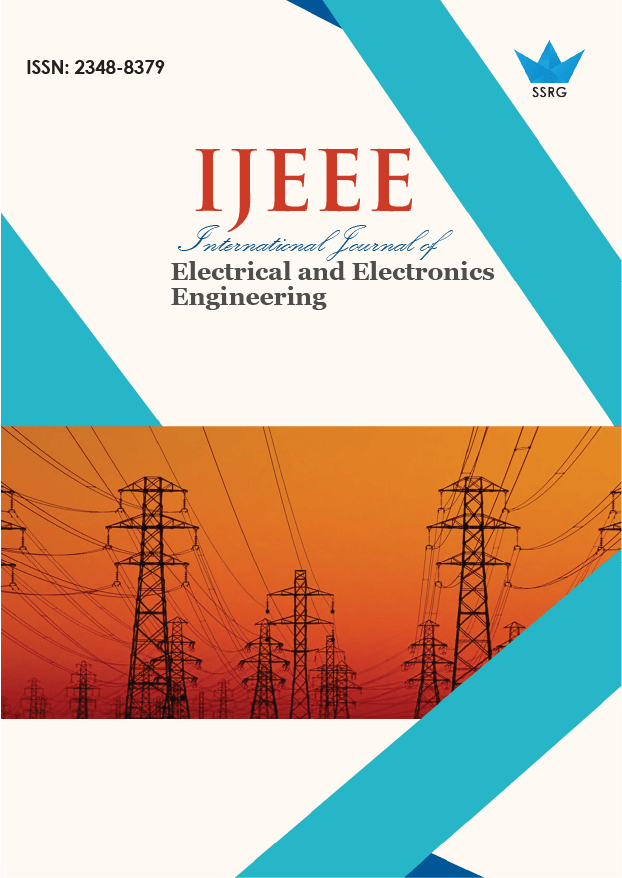Potential Analysis of Electricity Infrastructure Development Using Geographic Information System (GIS)-Fuzzy Logic - Solar PV Power Plant on Sumba Island

| International Journal of Electrical and Electronics Engineering |
| © 2024 by SSRG - IJEEE Journal |
| Volume 11 Issue 12 |
| Year of Publication : 2024 |
| Authors : Andi Wijaya, Didi Supriyadi Agustawijaya, Hartana |
How to Cite?
Andi Wijaya, Didi Supriyadi Agustawijaya, Hartana, "Potential Analysis of Electricity Infrastructure Development Using Geographic Information System (GIS)-Fuzzy Logic - Solar PV Power Plant on Sumba Island," SSRG International Journal of Electrical and Electronics Engineering, vol. 11, no. 12, pp. 150-159, 2024. Crossref, https://doi.org/10.14445/23488379/IJEEE-V11I12P114
Abstract:
As Indonesia's electricity demand grows, the shift from coal to renewable energy sources, especially solar power, is crucial. This study uses GIS and fuzzy logic to assess the potential for solar PV development on Sumba Island, a key renewable energy site. Evaluating 14 criteria and 8 constraints, the analysis identifies optimal locations for solar PV installation. Results reveal a potential capacity of 21,230.42 MWp, which could supply 52.32% of Indonesia’s projected 2030 electricity demand. Economic evaluations show a Levelized Cost of Electricity (LCOE) of 0.0478 to 0.0602 USD/kWh, a positive Net Present Value (NPV), and a Simple Payback Period (SPP) of 4.03 to 6.34 years. Additionally, this development could reduce CO2 emissions by up to 29,326,836.29 tons annually. These findings highlight Sumba Island's significant role in advancing Indonesia’s renewable energy goals and suggest further studies on integrating solar power into the national grid and optimizing HVDC transmission for efficient energy distribution.
Keywords:
PV, GIS, Fuzzy logic, Renewable energy, Sumba island.
References:
[1] PT PLN (Persero), Electricity Supply Business Plan (RUPTL) 2021 - 2030, Minister of Energy and Mineral Resources, Jakarta, pp. 1-915, 2021. [Online]. Available: https://web.pln.co.id/en/stakeholders/electricity-supply-business-plan
[2] Presidential Regulation (Perpres) Number 22 of 2017 concerning the National Energy General Plan, Database Peraturan, 2017. [Online]. Available: https://peraturan.bpk.go.id/Details/68772
[3] International Renewable Energy Agency, “Renewable Power Generation Costs in 2022 Renewable Power Generation Costs in 2022,” pp. 1-208, 2023.
[Google Scholar] [Publisher Link]
[4] Abraham Lomi, “Iconic Renewable Energy Island as an Independent Renewable Energy Pilot Island in Indonesia,” Prosiding SENIATI, vol. 2, no. 2, pp. 1–6, 2016.
[Google Scholar] [Publisher Link]
[5] Yassine Charabi, and Adel Gastli, “PV Site Suitability Analysis Using GIS-based Spatial Fuzzy Multi-Criteria Evaluation,” Renewable Energy, vol. 36, no. 9, pp. 2554-2561, 2011.
[CrossRef] [Google Scholar] [Publisher Link]
[6] Hossein Yousefi, Hamed Hafeznia, and Amin Yousefi-Sahzabi, “Spatial Site Selection for Solar Power Plants Using a GIS-Based Boolean-Fuzzy Logic Model: A Case Study of Markazi Province, Iran,” Energies, vol. 11, no. 7, pp. 1-18, 2018.
[CrossRef] [Google Scholar] [Publisher Link]
[7] Alfeus Sunarso et al., “GIS-Based Assessment of the Technical and Economic Feasibility of Utility-Scale Solar PV Plants: Case Study in West Kalimantan Province,” Sustainability, vol. 12, no. 15, pp. 1-12, 2020.
[CrossRef] [Google Scholar] [Publisher Link]
[8] Chia-Nan Wang et al., “Site Selection of Solar Power Plants Using Hybrid MCDM Models: A Case Study in Indonesia,” Energies, vol. 16, no. 10, pp. 1-24, 2023.
[CrossRef] [Google Scholar] [Publisher Link]
[9] Jae Heo et al, “Case Study of Solar Photovoltaic Power-Plant Site Selection for Infrastructure Planning Using a BIM-GIS-Based Approach,” Applied Sciences, vol. 11, no. 18, pp. 1-16, 2021.
[CrossRef] [Google Scholar] [Publisher Link]
[10] H. Ebru Colak, Tugba Memisoglu, and Yasin Gercek, “Optimal Site Selection for Solar Photovoltaic (PV) Power Plants Using GIS and AHP: A Case Study of Malatya Province, Turkey,” Renewable Energy, vol. 149, pp. 565-576, 2020.
[CrossRef] [Google Scholar] [Publisher Link]
[11] Yashar Rezaeisabzevar, Alireza Bazargan, and Behzad Zohourian, “Landfill Site Selection Using Multi Criteria Decision Making: Influential Factors for Comparing Locations,” Journal of Environmental Science, vol. 93, pp. 170-184, 2020.
[CrossRef] [Google Scholar] [Publisher Link]
[12] Richard L. Church, “Geographical Information Systems and Location Science,” Computer and Operations Research, vol. 29, no. 6, pp. 541-562, 2002.
[CrossRef] [Google Scholar] [Publisher Link]
[13] Gökhan Şahin, Ahmet Koç, and Wilfried van Sark, “Multi-Criteria Decision Making for Solar Power-Wind Power Plant Site Selection Using a GIS-Intuitionistic Fuzzy-Based Approach with an Application in the Netherlands,” Energy Strategy Reviews, vol. 51, 2024.
[CrossRef] [Google Scholar] [Publisher Link]
[14] Marzieh Mokarram, Tam Minh Pham, and Mohammad Hassan Khooban, “A Hybrid GIS-MCDM Approach for Multi-Level Risk Assessment and Corresponding Effective Criteria in Optimal Solar Power Plant,” Environmental Science and Pollution Research, vol. 29, pp. 84661-84674, 2022.
[CrossRef] [Google Scholar] [Publisher Link]
[15] Farzam Hasti et al., “Optimal Solar Photovoltaic Site Selection Using Geographic Information System–Based Modeling Techniques and Assessing Environmental and Economic Impacts: The case of Kurdistan,” Solar Energy, vol. 262, 2023.
[CrossRef] [Google Scholar] [Publisher Link]
[16] Moein Besharati Fard et al., “Ground-Mounted Photovoltaic Power Station Site Selection and Economic Analysis Based on a Hybrid Fuzzy Best-Worst Method and Geographic Information System: A Case Study Guilan Province,” Renewable and Sustainable Energy Reviews, vol. 169, 2022.
[CrossRef] [Google Scholar] [Publisher Link]
[17] Kamaleddin Aghaloo et al., “Optimal Site Selection for the Solar-Wind Hybrid Renewable Energy Systems in Bangladesh Using an Integrated GIS-Based BWM-Fuzzy Logic Method,” Energy Conversion and Management, vol. 283, 2023.
[CrossRef] [Google Scholar] [Publisher Link]
[18] Ashley Morris, and Piotr Jankowski, Spatial Decision Making Using Fuzzy GIS, Fuzzy Modeling with Spatial Information for Geographic Problems, Springer, pp. 275–298, 2005.
[CrossRef] [Google Scholar] [Publisher Link]
[19] Pablo Benalcazar, Aleksandra Komorowska, and Jacek Kamiński, “A GIS-Based Method for Assessing the Economics of Utility-Scale Photovoltaic Systems,” Applied Energy, vol. 353, 2024.
[CrossRef] [Google Scholar] [Publisher Link]
[20] Neil Reid et al., GIS and Economic Development, Planning and Socioeconomic Applications, Springer, Dordrecht, pp. 5–28, 2009.
[CrossRef] [Google Scholar] [Publisher Link]
[21] Hassan Z. Al Garni, and Anjali Awasthi, “Solar PV Power Plant Site Selection Using a GIS-AHP based Approach with Application in Saudi Arabia,” Applied Energy, vol. 206, pp. 1225-1240, 2017.
[CrossRef] [Google Scholar] [Publisher Link]
[22] Rebecca R. Hernandez et al., “Solar Energy Development Impacts on Land Cover Change and Protected Areas,” Proceedings of the National Academy of Sciences (PNAS), vol. 112, no. 44, pp. 13579-13584, 2015.
[CrossRef] [Google Scholar] [Publisher Link]
[23] Bahaa Elboshy et al., “A Suitability Mapping for the PV Solar Farms in Egypt Based on GIS-AHP to Optimize Multi-Criteria Feasibility,” Ain Shams Engineering Journal, vol. 13, no. 3, 2022.
[CrossRef] [Google Scholar] [Publisher Link]
[24] Jay R.S. Doorga, Soonil D.D.V. Rughooputh, and Ravindra Boojhawon, “Multi-Criteria GIS-Based Modelling Technique for Identifying Potential Solar Farm Sites: A Case Study in Mauritius,” Renewable Energy, vol. 133, pp. 1201-1219, 2019. [CrossRef] [Google Scholar] [Publisher Link]
[25] Puteri Nur Atiqah Bandira et al., “Optimal Solar Farm Site Selection in the George Town Conurbation Using GIS-Based Multi-Criteria Decision Making (MCDM) and NASA Power Data,” Atmosphere, vol. 13, no. 12, pp. 1-27, 2022.
[CrossRef] [Google Scholar] [Publisher Link]
[26] Joseph Amajama, and Daniel Effiong Oku, “Effect of Relative Humidity on Photovoltaic Panels’ Output and Solar Illuminance/Intensity,” Journal of Scientific and Engineering Research, vol. 3, no. 4, pp. 126–130, 2016.
[Google Scholar] [Publisher Link]
[27] Osarumen O. Ogbomo et al., “A Review of Photovoltaic Module Technologies for Increased Performance in Tropical Climate,” Renewable and Sustainable Energy Reviews, vol. 75, pp. 1225-1238, 2017.
[CrossRef] [Google Scholar] [Publisher Link]
[28] Damon Waterworth, and Alona Armstrong, “Southerly Winds Increase the Electricity Generated by Solar Photovoltaic Systems,” Solar Energy, vol. 202, pp. 123-135, 2020.
[CrossRef] [Google Scholar] [Publisher Link]
[29] P.G. Kosmopoulos et al., “Solar Energy Prediction and Verification Using Operational Model Forecasts and Ground-Based Solar Measurements”, Energy, vol. 93, pp. 1918-1930, 2015.
[CrossRef] [Google Scholar] [Publisher Link]
[30] Ehsan Noorollahi et al., “Land Suitability Analysis for Solar Farms Exploitation Using GIS and Fuzzy Analytic Hierarchy Process (FAHP) - A Case Study of Iran,” Energies, vol. 9, no. 8, pp. 1-24, 2016.
[CrossRef] [Google Scholar] [Publisher Link]
[31] Fitria Sawitri, “Integration of GIS and MCDM to Evaluate PLTS Location Determination, Case Study in Kupang Regency, East Nusa Tenggara,” Undergraduate Thesis, Institut Teknologi Sepuluh Nopember, pp. 1-76, 2016.
[Google Scholar] [Publisher Link]
[32] N.A. Tanjung, E. Rustiadi, and Widiatmaka, “Suitable and Available Land for Settlement Development in Cianjur Regency,” Journal of Natural Resources and Environmental Management, vol. 11, no. 4, pp. 550-566, 2021.
[CrossRef] [Google Scholar] [Publisher Link]
[33] Mahmood Zoghi et al., “Optimization Solar Site Selection by Fuzzy Logic Model and Weighted Linear Combination Method in Arid and Semi-Arid Region: A Case Study Isfahan-Iran,” Renewable and Sustainable Energy Reviews, vol. 68, pp. 986-996, 2017.
[CrossRef] [Google Scholar] [Publisher Link]
[34] Harold Steven Ruiz et al., “GIS-AHP Multi Criteria Decision Analysis for the Optimal Location of Solar Energy Plants at Indonesia,” Energy Reports, vol. 6, pp. 3249-3263, 2020.
[CrossRef] [Google Scholar] [Publisher Link]
[35] Manoochehr Mortazavi Chamchali, and Akbar Ghazifard, “The Use of Fuzzy Logic Spatial Modeling via GIS for Landfill Site Selection (Case Study: Rudbar-Iran),” Environmental Earth Science, vol. 78, 2019.
[CrossRef] [Google Scholar] [Publisher Link]
[36] Sarah M. Lewis et al., “Fuzzy GIS-based Multi-Criteria Evaluation for US Agave Production as a Bioenergy Feedstock,” GCB Bioenergy, vol. 7, no. 1, pp. 84-99, 2014.
[CrossRef] [Google Scholar] [Publisher Link]
[37] Agus Praditya Tampubolon et al., “Beyond 207 Gigawatts: Unleashing Indonesia’s Solar Potential,” Institute for Essential Services Reform (IESR), pp. 1-38, 2021.
[Publisher Link]
[38] Mahmoud Lurwan Sabo et al., “Spatial Matching of Large-Scale Grid-Connected Photovoltaic Power Generation with Utility Demand in Peninsular Malaysia,” Applied Energy, vol. 191, pp. 663-688, 2017.
[CrossRef] [Google Scholar] [Publisher Link]
[39] Solar Resource and Photovoltaic Potential of Indonesia, World Bank Group, pp. 1-86, 2017. [Online]. Available: https://documents.worldbank.org/en/publication/documents-reports/documentdetail/729411496240730378/solar-resource-and-photovoltaic-potential-of-indonesia
[40] Jannis Langer et al., “Geospatial Analysis of Indonesia’s Bankable Utility-Scale Solar PV Potential Using Elements of Project Finance,” Energy, vol. 283, 2023.
[CrossRef] [Google Scholar] [Publisher Link]
[41] I. Nyoman Candra Erawan, I. Nyoman Setiawan, and I. Wayan Sukerayasa, “Analysis of Carbon Emission Mitigation and Economics of a 463.25 kWp On Grid Rooftop Solar Power Plant (PLTS) at a Pharmaceutical Company in the PT Jakarta Industrial Estate Pulogadung Area, East Jakarta,” Jurnal SPEKTRUM, vol. 10, no. 3, pp. 29–37, 2023.
[Google Scholar] [Publisher Link]
[42] Panduan Studi Kelayakan Pembangkit Listrik Tenaga Surya (Plts) Terpusat, Indonesia Clean Energy Development II, 2018. [online]. Available: https://www.studocu.id/id/document/universitas-hasanuddin/teknik-elektro/panduan-fs-plts-terpusat-03-07012019-final-spread/46474079
[43] His Muhammad Bintang, “Making Energy Transition Succeed: A 2023’s Update on The Levelized Cost of Electricity (LCOE) and Levelized Cost of Storage (LCOS),” Institute for Essential Services Reform (IESR), pp. 1-77, 2023.
[Publisher Link]
[44] JETP Comprehensive Investment and Policy Plan, Just Energy Transition Partnership Indonesia (JETP), pp. 1-334, 2022. [Online]. Available: https://jetp-id.org/cipp
[45] Yan-wei Sun et al., “GIS-Based Approach for Potential Analysis of Solar PV Generation at The Regional Scale: A Case Study of Fujian Province, Energy Policy, vol. 58, pp. 248-259, 2013.
[CrossRef] [Google Scholar] [Publisher Link]
[46] Accelerating the Development of Renewable Energy for the Supply of Electricity,” Ministry of State Secretaries, 2022. [Online]. Available: https://peraturan.bpk.go.id/Details/225308/perpres-no-112-tahun-2022
[47] Paket Pelatihan, Pembiayaan Pembangkit Listrik Tenaga Surya, United States Agency International Development (USAID), pp. 1-48, 2016. [Online]. Available: https://www.scribd.com/document/353759109/Modul-05-Pembiayaan-Pembangkit-Listrik-Tenaga-Surya
[48] Decree of the Minister of Energy and Mineral Resources Number 163.K/HK.02/MEM.S/2021 concerning Determination of Greenhouse Gas Emission Factors for Electricity Systems,” Ministry of Energy and Mineral Resources, pp. 1-13, 2021. [Online]. Available: https://jdih.esdm.go.id/index.php/web/result/2183/detail

 10.14445/23488379/IJEEE-V11I12P114
10.14445/23488379/IJEEE-V11I12P114